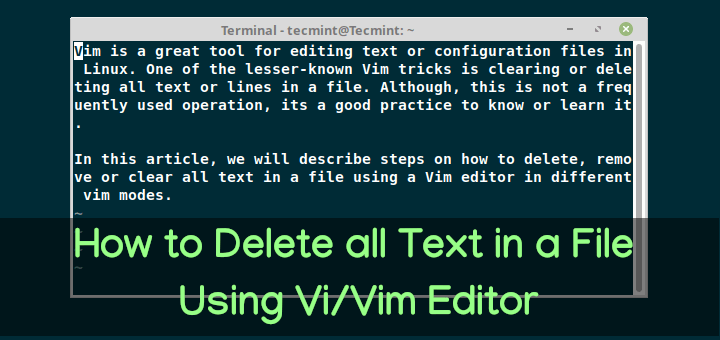


The global command, g for short, applies a command on each line that matches the pattern. If multiple lines are highlighted, pressing J will merge them all into a single line. If you press J with nothing highlighted, it will remove the current line ending and white-space bringing the next line up. Pressing dd multiple times will delete multiple lines. Type dd and hit Enter to remove the line. Place the cursor on the line you want to delete. If you'd prefer to have this be a single command you can define a custom command. :89d Note that this will also cause you to navigate to the location of the change. Below are step-by-step instructions to delete a line: Press the Esc key to go to normal mode. 3 Answers Sorted by: 70 The address of a colon-command (eg: the line number) comes first. : Enter INSERT mode at end of line Merge lines The command to delete a line in Vim is dd. : Go to last line in buffer Line INSERT mode The change equivalent is C, to delete from cursor to end of line, and switch to insert mode. You can paste a deleted or yanked line elsewhere, use p to paste.Īnother useful shortcut is D, to delete from cursor to end of line, equivalent to d$ But the newly typed-in content can be removed. If I quit insert mode, and open insert mode again, this Hello can't be removed by delete key. Since these are common actions, the double letter shortcuts are easier to remember and type. Firstly, I typed something on insert mode, like Hello At this stage, if I didn't exit from insert mode, delete key works and can delete the whole word if I want. The above are equivalent to using the _ motion. Use cc to delete line and enter INSERT mode. Run :Lazy clean to remove any disabled or unused plugins. Shortcuts exist for copying and deleting the current line. AstroNvim is an aesthetic and feature-rich neovim config that is extensible and easy to use. Vim has numerous built-in functions and features to operate specifically on lines. dG deletes all lines starting from the line under the cursor However, those only work in normal mode. d deletes to the end of the line, starting at the cursor. 5dd deletes multiple (5) lines, starting at the cursor. You can still use line editors for quick edits as well as scripts, which is why they've stuck around on modern Linux systems.Lines - Vim - mkaz.blog mkaz.blog Contents Vim Vi The Short Answer dd deletes the whole line under the cursor. This will delete upto but not including c. MS-DOS even came with one, Edlin, which was the only editor Microsoft supplied with the system until the MS-DOS Editor. Most users found this far more convenient than the old line editors, and they stuck with them with the transition from terminals connected to a minicomputer or mainframe to desktop computers running terminal emulators and GUIs. When video terminals became popular, many people switched to screen editors because they could see the whole file at once. These devices also had a major influence on the length of Linux commands. Since these devices printed on paper, it was impractical to print a whole file just to change a few lines. Line editors were mainly used when most people used printing terminals, also known as teleprinters or teletypes, to interact with a computer. we yank 'foo' and delete 'bar' - the register 0 still contains 'foo' Hence 'foo' can be pasted using '0p. It's a text editor that works on one line at a time, as opposed to modern text editors that operate on full-screen buffers. VIM docs: Numbered register 0 contains the text from the most recent yank command, unless the command specified another register with 'x. Ex is a line editor, which is what it sounds like.


 0 kommentar(er)
0 kommentar(er)
